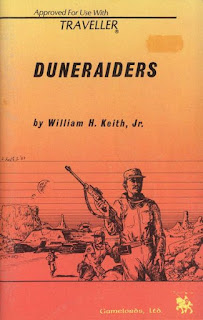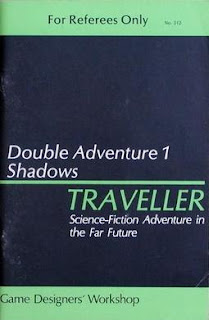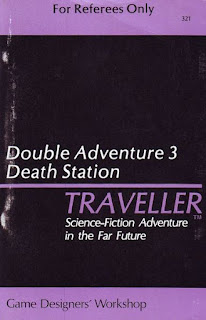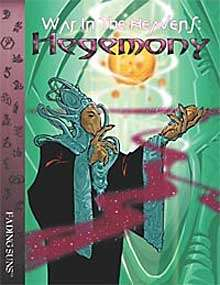In a comment to My Top 10 D&D Adventures of the Golden Age (Part II), fellow blogger Adam Dickstein asked me to produce a similar list of my favorite non-D&D adventures. I thought that was an excellent idea and so spent the last week thinking about the matter, resulting in the list below, which I hope will be of as much interest as my previous one. This one is a little different than my D&D-centric one in that it's not in any particular order. Given the wide range of roleplaying games for which these adventures were written, ranking them would, on some level, be like comparing apples and oranges.
As with my earlier list, this one is highly subjective, based almost entirely on my personal experiences with the adventures in question. I make no claims that any of what follows is "the best" in any absolute sense, only that they're personal favorites from more than four decades of roleplaying. In addition, I have deliberately limited myself to the single adventure I consider my favorite for each game system. I could easily have included multiple Traveller or Call of Cthulhu adventures, for example, but felt a broader list would better illustrate my personal tastes. That's also why there are only nine entries on this list rather than ten: I had a tough time coming up with adventures for ten different games that I have actually used and enjoyed, so I settled for nine.
The Traveller AdventureThe choice of Marc Miller's 1983 The Traveller Adventure is both obvious and something of a cheat. Unlike some of the entries on this list – though not all, as you'll see – this one more of a campaign framework than an single adventure. Despite its title, The Traveller Adventure gives the referee enough material for months of play in GDW's Third Imperium setting. After the kick-off scenario, the players have an immense range of options, as they pilot their merchant vessel among the worlds of the Aramis subsector of the Spinward Marches. Though there's an overarching narrative thread, it's not heavy-handed. That's vital in a game like Traveller, which, as its title suggests, is built on the characters' freedom to travel where they wish among the worlds of its far future setting. While not perfect – what is? – I've gotten untold hours of fun out of The Traveller Adventure and use it as a model for how to present freewheeling campaign-building material.
Bugs in the System

You'll find that there are a number of science fiction adventures on this list, which should come as no surprise to those who read this blog regularly. Bugs in the System by Graeme Morris is one of two modules published by TSR UK for Star Frontiers. Unlike many of the scenarios published for the game, this one is relatively slow-paced, focusing on scientific and technological investigation rather than combat. The characters are tasked with figuring out what went wrong on an extraction platform in orbit around a gas giant contact with which has recently been lost. Unraveling the mystery requires careful analysis of the facts on the ground as much as the quick thinking one typically associated with RPGs. What elevates Bugs in the System above so many other modules of this sort is that the central mystery is genuinely science fictional in nature and quite different from what could be found in other Star Frontiers modules. I regularly find myself thinking back on this one.
Trouble BrewingThis one is something of a cheat too, in that it's not a single adventure but rather an overview of a campaign setting, along with several different scenarios, each of which highlights part of that setting. That said, Trouble Brewing is absolutely wonderful, both in its utility to the referee running a Gangbusters campaign and in the options it makes available to the players. The scenarios presented here run the range from law enforcement to journalism to independent and syndicate crime. One of the things I still find incredibly attractive about Gangbusters is the evenness with which it treated character options. The rules treat being an investigative reporter as every bit as viable as being a gangster or private eye. Trouble Brewing follows in the same vein, offering up scenarios and situations intended for all types of characters. I got immense use out of this product.
Legion of Gold
I have been known to call Legion of Gold "the Village of Hommlet" of Gamma World, which is high praise considering that Hommlet is my favorite D&D adventure of all time. I mean that comparison most sincerely. Legion of Gold presents a community of relative safety and prosperity – the Barony of Horn – for use as a home base by a band of newly created player characters. Once established there, the characters begin exploring the surrounding countryside, undertaking small missions for local patrons. In the process, they not only make names for themselves but also start to hear rumors of a growing threat, the eponymous Legion of Gold. The Legion seemingly appeared out of nowhere and, armed with mighty weapons of the Ancients, seems bent on conquest not just of the Barony but all the lands near Lake Mitchigoom. There's plenty of material to sustain a Gamma World campaign for months packed into this module's 32 pages. Great stuff.
The VanishedFASA's Star Trek the Roleplaying Game remains my favorite adaptation of the venerable science fiction series into the medium of roleplaying. During its existence in the early to mid-1980s, FASA published an outstanding number of truly excellent adventures for the game, many of which compare favorably with episodes from the Original Series. A good example of this is 1983's The Vanished. The scenario is similar in some respects to Bugs in the System above, in that the player characters are investigating unexplained events aboard a space station that has resulted in the disappearance of its crew. This is a slow, methodical scenario that rewards keen eyes and clever thought, but it's also immensely rewarding, as the characters uncover the true cause of what's happening and must resolve it according to the principles of Starfleet. I had much fun with this adventure and still consider it one of highlights of FASA's output for the game.
Shadows of Yog-Sothoth
This entry is another cheat in that Shadows of Yog-Sothoth is a campaign for Chaosium's Call of Cthulhu rather than a single adventure. On the other hand, Call of Cthulhu tends to be known more for its campaigns than for its individual scenarios, so I feel quite justified in choosing it. More to the point, this is one of the earliest supplementary products published by Chaosium, so its influence and impact cannot be understated. As a neophyte Keeper, I welcomed the release of Shadows of Yog-Sothoth in 1982 and ran it to great success with my players, who enjoyed every bit of it – even the final confrontation with Cthulhu himself. To this day, whenever I think of refereeing Call of Cthulhu, I find myself thinking back to Sandy Petersen's masterpiece. It's exceptionally well done, with lots of variety in its sanity-shattering horrors and the overall structure, while Derlethian in its frame, is quite satisfying.
The Free City of KrakowTwilight: 2000 is a favorite RPG of mine, one I bought immediately upon its release in 1984 and played with great gusto with my friends at the time. Over the years, I've retained an immense fondness for it, owing in large part to my memories of the days we spent in the then-possible future of the Year 2000. Much of those days were spent in and around the titular Free City of Krakow, a sovereign city-state that conducts itself independently of both the Warsaw Pact and NATO. Within its walls, almost anything is available for the right price, most especially information. This module, like so many others on this list, presents multiple possible scenarios in which the characters might become involved, in addition to plenty of information about Krakow and its inhabitants. The characters in my campaign of yore spent many months in the Free City, in the process becoming involved in local politics and intrigue. I can't say enough good things about this one.
War in Heaven: HegemonyBecause the focus of this blog is old school roleplaying games, I generally don't write much about RPGs published after the mid-1980s, but one of my favorite games is Fading Suns, first published in 1996. Fading Suns is a science fantasy roleplaying game set thousands of years in the future after the fall of the high-tech Second Republic. What follows is a literal dark age, as the stars themselves begin to fade due to some unknown – and possibly supernatural – phenomenon. War in Heaven: Hegemony is the second part of an unfinished trilogy of adventures dealing with the mysteries of the setting, in this case the enigmatic aliens known as the Vau. The scenario involves the player characters being selected as part of a diplomatic mission to Vau space, during which they learn more about these aliens, the culture, and beliefs. It's a little heavy-handed at times, but I am fond of it nonetheless because of the masterful way author Bill Bridges deploys religious beliefs, esoteric thought, and science fictional concepts to create memorable situations with which the characters must contend.

Again, I cheat – I am sensing a pattern here – in that Greg Stafford's The Boy King isn't a single adventure so much as a campaign framework into which the referee can insert any adventure scenarios he likes. In my defense, I can only say that, despite this, the book does include numerous ready-to-play scenarios, not to mention plenty of background information, locations, and NPC descriptions from which to create many, many more. It's a nearly perfect toolbox for any Pendragon referee, giving him everything needed to run a 80-year campaign, spanning the time between the time of Uther to the death of Arthur. Without exaggeration, The Boy King is the only supplement a Pendragon referee will ever require to keep his campaign humming along for many months, if not years. It's a brilliant piece of work and I've gotten so much use out of it over the years that I had to include it on this list.




































